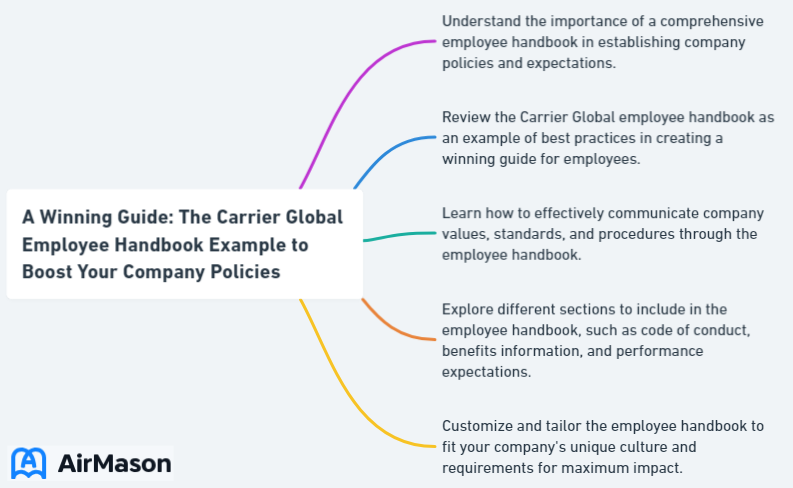
Are you looking to create an employee handbook that not only informs but also engages and motivates your employees? Look no further! A well-crafted employee handbook is instrumental in setting expectations and creating a positive work environment. In this blog post, we will guide you through the process of creating a successful employee handbook by taking inspiration from the Carrier Global Employee Handbook Example and incorporating essential elements, best practices, and additional considerations.
Key Takeaways
- The Carrier Global Employee Handbook provides a comprehensive and inspirational guide to craft an effective employee manual.
- Crafting an employee handbook reflects the company’s values, is legally compliant, and includes essential elements such as workplace policies, code of conduct & compensation/development.
- Implementing & updating regularly ensures employees have access to key information on culture & policies while onboarding new hires efficiently.
Fortune 100 Company Employee Handbook
In the comprehensive Fortune 100 Company Employee Handbook, our organization’s commitment to fostering a positive and inclusive work environment is highlighted. The Fortune 100 Company Employee Handbook serves as a valuable resource, providing detailed insights into company policies, procedures, and expectations. Employees can rely on this handbook as a guide for understanding their rights, responsibilities, and the core values that define our corporate culture. With a focus on transparency and clarity, the Fortune 100 Company Employee Handbook is designed to empower our workforce, ensuring everyone is equipped with the necessary information to thrive in their roles.
The Carrier Global Employee Handbook Inspiration
The Carrier Global Employee Handbook serves as an excellent example to emulate when crafting your own employee manual. This handbook effectively covers various aspects that are crucial for a comprehensive guide, such as a strong emphasis on company culture, clear and concise policies, and an extensive overview of employee benefits.
Emulating the approach of the Carrier Global Employee Handbook allows you to develop a manual that both complies with relevant laws and effectively conveys your company’s values and expectations to your staff. This ensures that your workforce is well-informed and empowered to make responsible decisions in their day-to-day work, ultimately contributing to a more efficient and harmonious work environment.

Emphasis on company culture
Company culture plays a vital role in employee satisfaction and retention. A well-defined culture fosters a sense of belonging and trust among employees, reducing ambiguity and potential misunderstandings. Incorporating your company’s values, mission, and vision in the employee handbook promotes a sense of unity and shared purpose within the organization.
For example, the Carrier Global Employee Handbook incorporates the following elements:
- Integrity
- Respect
- Collaboration
- Innovation
- Customer focus
- Diversity and inclusion
- Accountability
- Work-life balance
A clear outline of these core values enables your employees to understand how their individual roles contribute to the company’s overall success, fostering an engaged and motivated workforce.
Clear and concise policies
An effective employee handbook should feature clear and concise policies that are easily understood by all employees. Employee handbook examples of such policies include:
- Equal opportunity
- Workplace health and safety
- Employee code of conduct
- Attendance
- Dress code
- Work hours
These policies, including life insurance, should be tailored to align with the specific benefits and opportunities your company offers, keeping in mind the best interests of your employees and the proper management of company property.
To achieve clarity and conciseness in your policies, consider using tools and methods such as Hemingway App, Grammarly, and PowerDMS document management tools. Strategies like reading your policies aloud, obtaining peer feedback, and using online resources enhance their precision and accuracy. Regular performance reviews can also reinforce adherence to these policies and uphold a professional standard, while a well-defined disciplinary process ensures compliance.
Comprehensive benefits overview
A thorough overview of employee benefits is essential for attracting and retaining top talent. Your employee handbook should detail various benefits such as:
- Health insurance
- Retirement plans
- Paid time off
- Flexible work schedules
- Employee assistance programs
- Wellness programs
- Tuition reimbursement
- Employee discounts
- Commuter benefits
These benefits, including workers compensation, demonstrate your company’s commitment to employee well-being.
For example, an average cost of health insurance benefits for employees is approximately $16,357 for family coverage and $6,584 for single coverage per employee annually. Providing comprehensive information on these costs and other benefits in your employee handbook ensures that your employees grasp the complete spectrum of support and opportunities your company offers.
Crafting Your Own Employee Manual

To create an employee manual that is both legally compliant and tailored to your company’s unique culture, it is crucial to align with applicable laws and customize the content accordingly. This involves understanding and adhering to local, state, and federal employment laws, as well as incorporating your company’s mission, vision, and values into the handbook.
Following these guidelines allows you to create an employee manual that serves as a valuable resource for your workforce, providing a clear understanding of company policies, expectations, and growth opportunities. This contributes to an efficient, harmonious, and successful work environment.
Aligning with applicable laws
Ensuring your employee handbook complies with applicable laws is of utmost importance to avoid legal issues. Some essential legal requirements for an employee manual include:
- Providing notice and a disclaimer/acknowledgment of receipt
- Adhering to employment at-will policies
- Implementing equal employment opportunity policies
- Establishing anti-discrimination and anti-harassment policies
To ensure compliance with employment laws, consider the following measures:
- Regularly reviewing federal, state, and applicable law
- Seeking legal advice from professionals specializing in employment law, while being mindful of legal fees
- Adapting your policies to align with industry-specific regulations
- Using clear and concise language to avoid misinterpretation
Taking these measures protects your company and employees to the full extent from possible legal disputes and guarantees a seamless, legally compliant work environment.
Customizing for your company
Customizing your employee handbook allows you to create a resource that truly reflects your company’s unique culture, values, and policies. Start by incorporating your company’s history, mission, and vision into the handbook to provide employees with a comprehensive understanding of your organization’s purpose and goals.
In addition, consider including information on company-specific policies such as:
- dress code
- paid time off
- parking regulations
- procedures for reimbursement
- communication
- notice period
Tailoring your handbook to your company’s specific needs and culture will not only create a valuable resource for employees but also contribute to a more engaged and motivated workforce.
Coupang Employee Handbook Example
Embarking on a journey through the Coupang employee handbook example provides a comprehensive insight into the values and principles that define our organizational culture. Within the pages of this handbook, Coupang’s commitment to fostering a collaborative and inclusive work environment is vividly articulated. The Coupang employee handbook example serves as a guide, offering employees a roadmap to navigate their professional endeavors, ensuring alignment with the company’s mission and vision. From workplace policies to growth opportunities, this handbook encapsulates the essence of what it means to be part of the Coupang team. Explore this resource to understand the core tenets that shape our workplace dynamics and contribute to the success of both individuals and the organization as a whole.
Essential Elements of an Employee Handbook

An effective employee handbook should include essential elements such as workplace policies, a code of conduct, and information on compensation and development. These elements provide a foundation for a well-rounded, informative resource that can guide employees through their professional journey within your organization.
Ensuring your employee handbook covers these essential elements promotes a positive work environment where employees understand their responsibilities and expectations. This contributes to a harmonious and efficient workplace and helps prevent potential conflicts and misunderstandings.
Workplace policies and procedures
Clearly outlining workplace policies and procedures is crucial for maintaining a smooth and efficient work environment. Your employee handbook should detail important policies such as:
- Dress code
- Paid time off
- Parking guidelines
- Reimbursement processes
In addition, make sure to address any legally required policies, such as equal employment opportunity, anti-discrimination and anti-harassment, and workplace health and safety. Providing employees with a comprehensive understanding of these policies ensures they are well-equipped to meet company expectations and contribute to a successful work environment.
Moreover, your employee handbook should include any company-specific policies that reflect your unique culture and values. Tailoring your workplace policies to your organization’s specific needs and requirements creates a more personalized and engaging resource for your employees, further promoting a positive and inclusive work environment.
Code of conduct
Establishing a code of conduct in your employee handbook is essential for promoting ethical behavior and maintaining a positive workplace atmosphere. This section should outline the expected behavior and standards of conduct for employees in the workplace, as well as potential disciplinary actions to ensure consistency in handling misconduct situations.
Examples of code of conduct policies from successful companies such as:
- Microsoft
- Apple
- Amazon
can serve as inspiration for creating your own. Providing clear guidelines for employee behavior and demonstrating your organization’s commitment to ethical conduct fosters a work environment built on trust, respect, and accountability.
Compensation and development
Providing information on compensation, performance evaluations, and opportunities for professional development not only demonstrates your company’s commitment to employee growth but also helps employees understand their potential within the organization. Your employee handbook should include details on compensation factors such as market salary rates, job title, responsibilities, location, and internal and external factors.
In addition, outline the process for performance evaluations, including the criteria used to assess performance and any opportunities for professional development, such as training programs, conferences, and mentorship initiatives. By keeping employees informed about their compensation and development opportunities, you can motivate them to reach their full potential and contribute to your company’s success.
Additional Considerations for Your Employee Handbook

In today’s dynamic work environment, it’s important to address additional considerations such as remote work, flexible hours, and data privacy and security in your employee handbook. These topics not only reflect the changing nature of work but also demonstrate your company’s commitment to adapting to employee needs and industry trends.
Incorporating these additional considerations into your employee handbook creates a more comprehensive and relevant resource that effectively addresses the concerns and needs of your employees. This contributes to a more inclusive and accommodating work environment and helps employees feel supported and valued within your organization.
Addressing remote work and flexible hours
As remote work becomes increasingly common, it’s essential to include policies on remote work and flexible hours in your employee handbook. These policies should outline the guidelines and expectations for employees working remotely, including communication and collaboration expectations, performance standards and metrics, and technology and equipment requirements.
In addition, consider specifying the flexibility in work hours, such as allowing employees to choose their start and end times within a certain window or implementing a results-oriented approach rather than strict schedules. Addressing remote work and flexible hours accommodates the diverse needs of your employees and promotes a more inclusive and adaptable work environment.
Ensuring data privacy and security
Data privacy and security is a critical concern for businesses, and your employee handbook should address the measures taken to protect sensitive company and employee information. This includes:
- Adhering to global privacy laws
- Safeguarding personally identifiable information (PII)
- Implementing data security measures
- Ensuring employee data protection
Outlining your company’s data privacy and security policies in your employee handbook demonstrates your commitment to protecting sensitive information and instills confidence in your employees. This also helps employees understand their own responsibilities when it comes to data protection and contributes to a more secure and privacy-conscious work environment.
Implementing and Updating Your Employee Handbook
Implementing and updating your employee handbook is crucial for onboarding new employees and keeping current employees informed of any changes. Providing new hires with access to your employee handbook during the onboarding process helps them understand company policies, culture, and expectations from day one.
Regularly revising and updating your employee handbook ensures that it remains a relevant and useful resource for your workforce. This includes reflecting changes in company policies, laws, and industry best practices. By staying up-to-date and responsive to changes, you can maintain a comprehensive and informative employee handbook that supports the professional growth and success of your employees.
Onboarding new employees

An employee handbook is an invaluable tool for onboarding new hires, providing them with a comprehensive understanding of company policies and expectations. By incorporating your employee handbook into the onboarding process, you can help new employees become acquainted with their roles and responsibilities within the organization.
In addition to providing the employee handbook, consider emphasizing key information during onboarding, such as company culture and values, work environment, and company policies and procedures. This will not only help new hires feel more confident and prepared but also contribute to a more seamless and successful onboarding experience.
Regular revisions and updates
Regularly revising and updating your employee handbook is essential for ensuring its continued relevance and usefulness. As company policies, laws, and industry best practices evolve, keeping your handbook up-to-date and in sync with these developments is key.
Some recommended procedures for periodically examining your handbook include:
- Verifying that policies accurately reflect actual circumstances
- Demonstrating adherence to laws and regulations
- Maintaining a positive and professional tone
By instituting a regular timetable for handbook updates, you can ensure that your employees have a reliable and current resource to guide them through their professional journey within your organization.
Halliburton Employee Handbook Example
In the comprehensive Halliburton employee handbook example, employees gain access to a wealth of essential information that guides them through the company’s policies and procedures. The Halliburton employee handbook example serves as a valuable resource, outlining expectations, benefits, and the overall culture within the organization. This document not only fosters a clear understanding of professional conduct but also ensures that employees are well-informed about the various resources available to them. With a focus on transparency and communication, the Halliburton employee handbook example plays a pivotal role in creating a positive and cohesive work environment for all team members.
Summary
In conclusion, a well-crafted employee handbook is instrumental in setting expectations and fostering a positive work environment. By taking inspiration from the Carrier Global Employee Handbook, incorporating essential elements, addressing additional considerations, and regularly revising and updating your handbook, you can create a comprehensive, informative, and engaging resource for your employees. Remember, an effective employee handbook not only informs but also motivates and promotes a harmonious and successful work environment.
Frequently Asked Questions
Is Carrier Global a good company?
Carrier Global appears to be a great company to work for, evidenced by its overall rating of 3.7 out of 5 based on reviews from its employees. It has also been ranked #31 on the Best Companies to Work For in America list. and named to TIME’s World’s Best Companies 2023 list.
What is Carrier Global known for?
Carrier Global Corporation is renowned for providing top-of-the-line heating, ventilation, air conditioning, refrigeration, fire and security systems, and building controls and automation. They are an American multinational based in Palm Beach Gardens, Florida, with 51 factories and 39 research & design centers worldwide serving customers in more than 180 countries.
How many employees does Carrier Global have?
Carrier Global had 58,000 employees on December 31, 2021 which decreased to 52,000 employees on December 31, 2022.
What does Carrier Global make?
Founded by the inventor of modern air conditioning, Carrier Global Corporation is a world leader in providing heating, ventilation, air conditioning (HVAC), refrigeration, fire, security, and building automation technologies. They specialize in residential air conditioners, heat pumps, and furnaces.
What are the key components of an effective employee handbook?
An effective employee handbook should include workplace policies, a code of conduct, and information on compensation and development, to ensure employees understand their rights and responsibilities.
Important Disclaimer:
The article presented here does not serve as a representation of the company’s actual employee handbook mentioned in this article.
Our discussions and insights regarding employee handbook are based on assumptions about what may be considered significant in this companies’ policies. These assumptions are drawn from available information and industry knowledge. Readers are advised that the content provided is for informational purposes only and should not be construed as an exact reflection of any company’s official policies or procedures. For precise and accurate details regarding a company’s employee handbook, individuals should refer directly to the company’s official documentation or consult with appropriate representatives.
Please be aware that the content on this page has been generated by using artificial intelligence language models and may contain errors, inconsistencies, or outdated information. It is provided as-is without any warranties or guarantees of accuracy. We strongly recommend using this content as a starting point for further research. We disclaim any liability for damages or losses resulting from the use or reliance on this content.